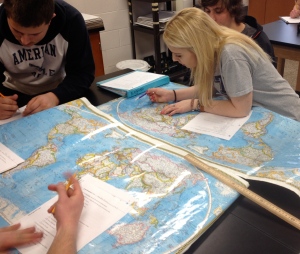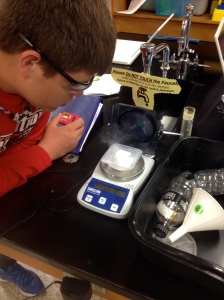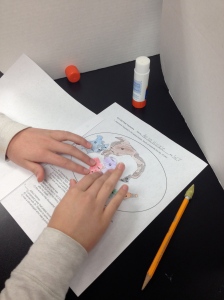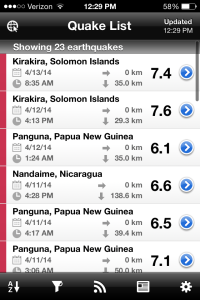IS II students used classic NatGeo maps to locate earth features and become more familiar with map reading (a lost art). Tomorrow they use the physical side of the map to located ocean features and link them to plate boundaries. Interesting to see them try to find Kiev, or Dakar, or Kuala Lumpur.
Monthly Archives: April 2014
Day 151: Rate of Dry Ice Sublimation
Students in IS I calculated the rate of sublimation of chunks of dry ice. For the longest time there was only one location in our county to purchase dry ice (local dairy main offices) and now we have to get it in the county to our west (Lancaster). We have to have a commuting teacher pick it up. Students enjoyed observing the dry ice in a beaker of warm water. They used the phase diagram to figure out the behavior of dry ice. They used Logger Pro to graph mass vs time and used the slope to come up with a sublimation rate in g/sec.
Day 150: Physics – Project Based Learning
OK, I admit that this photo is not of my class. My classes did more of the same today so photos would just be repeats. I had reason to stop by a colleagues class to see his Honor Physics students working on their own Van de Graaff generators. They even had a full-size drill press set up in the classroom. The pressure was on as the device HAD to work. Loved to see a student wearing his miniTHON shirt nearly two months after the event! Can’t wait for miniTHON2015.
Day 149: Fun, Fun, Fun (Beach Boys and Sand)
Day 148: Pangaea – Come Together, Right Now . . .
Day 147: Planet Configurations – Inferior Vocabulary
Students in astronomy were introduced to the confusing vocabulary of planetary configurations. Inferior vs. superior planets goes just fine, but things get troublesome when they find that an inferior planet can be in inferior conjunction or superior conjunction and that a superior planet can be in conjunction (note no inferior or superior here) or opposition. This simulation from U of Nebraska-Lincoln helps a lot.
Day 146: Ptolemy, Kepler, and Homer (Simpson)
As the astronomy students are introduced to Kepler’s Laws of Planetary motion, they learn how to draw ellipses and calculate eccentricity. They do some light reading on Ptolemy’s geocentric view of the universe and his epicycles. This gives me a chance to show the video clip below (showing epicycles can be used to explain just about any movement, right or wrong).
Day 145: Easter Bunny Visit
Day 144: Group II Solubility
IS I students did dilutions of Group II chloride solutions and then added 0.1M sodium sulfate to each to figure out any differences in solubility and reactivity. The first row is Mg+2, then Ca+2, Sr+2 and Ba+2. Note the precipitates that formed as sulphates of Sr and Ba are insoluble. Rows B, D, F, and H are empty.
Day 143: Earthquake Apps
I was excited to show my classes my seismometer app (iseismometer)
and one of my students was just as excited to show me that she had downloaded an earthquake alert app (QuakeFeed). It fit in perfectly with out discussion today of where earthquakes and volcanoes tend to be located and the recent quakes in the Soloman Islands.














